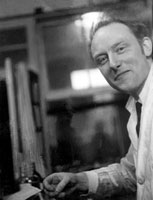 |
 |
|
 |
 |
 |
 |
 |
|
 |
 |
 |
 |

 |
 |
 |
 |

|
 |
Return to Table of Contents
 |
|
James Watson and a model of the double helix
|
|
MBL Summer 1954
Archival exhibit features an extraordinary era of scientific discoveries and the people who made them
It was the quintessential MBL summer.
Like Paris in the 1920s—which brought together artists and writers such as Picasso and Man Ray, Stein and Hemingway—Woods Hole in the summer of 1954 saw an extraordinary convergence of scientists. It was just one year after James Watson and Francis Crick published their groundbreaking paper on the structure of DNA in Nature, and both were here, Watson as a Physiology course instructor and Crick as a visiting scientist. Rosalind Franklin, whose X-ray crystallography helped elucidate the helical shape of DNA, was here, too. So were Albert Szent-Györgyi, Joshua Lederberg, Otto Loewi, Ruth Sager, and Libbie Hyman, along with many other notable scientists from around the world. What was that summer like? Why were all the notables here? “Science is We: MBL Summer 1954,” an exhibit featuring digitized images and memorabilia from the MBLWHOI Library archives and snapshots from private photo albums, answers this question in intimate detail.
|
 |
|
Francis Crick’s friendship with Watson was a critical influence in his career. Francis Crick died July 29, 2004.
|
“Science is We,” which is free and open to the public by appointment or chance, is on display in the Swope Center’s Meigs Room from now through Spring 2005. The exhibit was created by Ann Weissmann, exhibitions curator at the MBLWHOI Library and exhibition consultant at the New York Historical Society. Weissmann’s introductory graphic text summarizes the exhibit.
“. . . There is an unusual assortment of international scientists at work in the lab, conversing on campus or lazing on the beach. There is the formal course work and the informal parties shared by Nobel Prize winners and aspiring students alike. There are the sailing races, Hurricane Carol and the construction of an off-site ‘molecule’—one of Buckminster Fuller’s geodesic domes.”
“The idea of the exhibit was to describe the intellectual climate and social setting of that summer,” says Weissmann. According to her exhibit text, “These images evoke a sense of the period as well as of the community of science. They also demonstrate the informal and free exchange that has characterized summers at the MBL since its inception.” Indeed, the photographs range from serious images, such as one of molecular biologist Matt Meselson laboring at an ultracentrifuge, to more jocular group shots of scientists at play—in hula skirts or wearing the signature ties that indicated membership in the RNA Tie Club, a semi-fraternal organization whose members included Watson, Crick, Richard Feynman, and others.
There are also photographs depicting events that continue at the MBL today, such as a student gathering at Stony Beach. And there are fascinating views (and first-person accounts by Watson and Franklin) of old Woods Hole after Hurricane Carol tore through town the morning of August 31, 1954, leaving boats in the streets, decimating piers and buildings, and, according to Watson, “submerging all of the MBL’s ultracentrifuges.”
Weissmann says exhibits like “Science is We” are a great way to share the MBLWHOI Library’s archival riches with the public. But unlike the other three exhibits she created for the library, this time she augmented archival materials with photographs supplied by members of the MBL and Woods Hole community. “Many people were helpful and delighted to participate,” says Weissmann. “The photographs give the exhibit an immediate feel, more like a family album than a packaged exhibit.
”Weissmann and MBLWHOI Library director Catherine Norton devised the idea for “Science is We” in the spring of 2003, while viewing a New York Public Library exhibit celebrating the 50th anniversary of Watson’s and Crick’s scientific achievements. “Cathy pointed out that in the Summer of ‘54, Watson, Crick, and Franklin were all at the MBL, and there was good visual material in our archives,” says Weissmann. “I said, ‘Great! That’s a start! I like to show, not just tell.’ ” That the show could be mounted in Summer 2004, exactly 50 years after the Summer of ‘54, made the idea even more exciting.
Weissmann says the title and theme for “Science is We” were inspired by a quote from French biologist Claude Bernard who, when asked to explain the difference between art and science said, “L’art c’est moi; La science c’est nous.” (“Art is me; Science is we.”) “The exhibit is a tribute to the idea that science isn’t created by one person in a vacuum, but is rather a collaborative effort,” she says. And the photographs really do say it all.
|
|
| |
 |
|
 |
 |
|